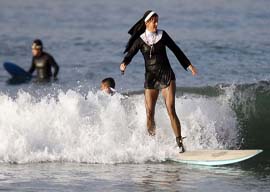
October 28, 2011

Here in California, Halloween is a season as much as a single holiday, beginning roughly in late August when the first magazines featuring holiday crafts appear, swiftly followed by drugstore and supermarket decorations. Yuletide trappings start to appear side-by-side with the Halloween things in a few places as early as mid-September, giving these establishments an eerie Nightmare Before Christmas look.
Halloween would serve California better as a national day than the Fourth of July. Certainly our spirit is more one of make-believe than independence.
But Halloween’s European roots morphed into something uniquely American before finally morphing into something uniquely Californian. New England’s beautiful foliage lays out a colorful backdrop for such chilling events as Salem’s Haunted Happenings and the annual pilgrimage to Lovecraft’s Grave in Providence. A mysterious cognac-toaster visits Poe’s Grave in Baltimore every Halloween night, and for many years little could rival the fearfulness of Detroit’s Devil’s Night. Spending on all aspects of Halloween, from costumes to candy, is up in 2011, with more money spent on adult costumes than children’s.
But Californians celebrate with a special gusto. Several major amusement destinations here transform into something unearthly for the occasion: Knott’s Berry Farm, the Queen Mary, Disneyland, and Universal Studios come immediately to mind. Universal was the birthplace of the modern incarnations of Dracula, Frankenstein, the Wolf Man, and the Mummy, all of whom have taken their places in the costume pantheon alongside the more traditional witches, ghosts, demons, and fairies.
Ever fond of dressing up in various guises, California’s homosexual community is an important component of the state’s Halloween culture. The holiday is erected into an almost sacred drama in areas with large gay populations—West Hollywood, for example, although San Francisco’s storied “Halloween in the Castro” was ultimately torpedoed due to a 2006 shooting incident.
From South of the Border has wafted north more than a touch of Mexico’s Dia de los Muertos, most notably at Los Angeles’s historic Plaza and in San Francisco. Contrary, however, to the writings and other inaccuracies of the Indigenista school, such Mexican and Latin American customs owe much more to Catholic practices of All Souls’ Day than to the Aztecs—as any native of New Orleans, Quebec, France, Hungary, Poland, Austria, Lithuania, or the rest of the Catholic world where indigenous Mesoamericans never trod can tell you. No taint of Catholicism affects East Asia’s religious customs, however, and although these festivals generally fall in late summer or early autumn, the Chinese Hungry Ghost Festival and the Japanese Obon are widely observed here. In areas with large numbers of these folk, there is a certain carry-over into the local Halloween observances.